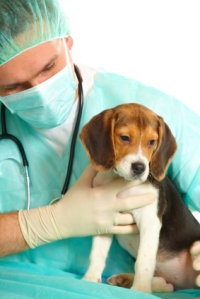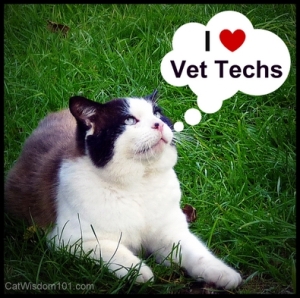It’s National Veterinary Technician Recognition Week. Just thought you’d like to know why veterinary technicians are a much needed and important member of the veterinary team:
1. Getting bit, scratched, peed on, or pooped on is just a routine hazard of the job.
While getting bit doesn’t happen THAT often since technicians are trained in proper restraint techniques, it still occurs. However, getting peed on and pooped on is a regular occurrence. Sometimes when Fido is super-nervous he piddles and it’s likely on the arm or leg of the tech helping to hold and calm said fearful Fido. Anal glands are a real treat and an unforgettable smell…watch a vet and a vet tech work together and you’ll know which vets have a history of a wide splash zone with such smelly procedures such as anal gland expression!
2. Techs are experts with venipuncture.
 Have you seen kitten veins? They are almost invisible! On top of that, have you ever seen a kitten sit still for a needle poke? My poor husband has notoriously bad veins for blood draws or catheter placement – I always joke with him that our technicians could hit his vein on the first try with their eyes closed. Okay, okay, maybe not quite with their eyes closed but it’s be pretty easy after trying to draw blood from the minuscule vein of a 1 pound wiggly kitten. The general population thinks that blood draws are the job of the veterinarian or that the veterinarian may be more skilled than the tech at blood draws but quite frankly, the techs have us beat on this one 9 times out of 10. Only every now and then do you get a vet who started out as a technician and might still retain his venipuncture expertise!
Have you seen kitten veins? They are almost invisible! On top of that, have you ever seen a kitten sit still for a needle poke? My poor husband has notoriously bad veins for blood draws or catheter placement – I always joke with him that our technicians could hit his vein on the first try with their eyes closed. Okay, okay, maybe not quite with their eyes closed but it’s be pretty easy after trying to draw blood from the minuscule vein of a 1 pound wiggly kitten. The general population thinks that blood draws are the job of the veterinarian or that the veterinarian may be more skilled than the tech at blood draws but quite frankly, the techs have us beat on this one 9 times out of 10. Only every now and then do you get a vet who started out as a technician and might still retain his venipuncture expertise!
3. Hospitalized pets receive most of their care at the hands of the tech
Again, probably thought to be the job of the veterinarian, but the tech is the person who is likely to carry out the treatments that are “ordered” by the vet. When a pet patient is admitted to the hospital, the veterinarian examines the pet and decides necessary treatments – be it anything from IV fluids to oral medications. The tech then has to carry out these treatments and the monitoring schedule set up by the vet. If anything changes the tech is likely to be the one to alert the doctor who then again re-evaluates and re-plans for further diagnostics or treatments. I’ve seen many a tech also spending that extra time to tuck hospitalized patients into a warm bed or to hand feed sick pets who would otherwise not be eating. They truly care and go the extra mile without much recognition.
4. Techs educate pet owners on an daily basis – every time they step in an exam room
What diets should I feed and how much? What is heartworm? How do I get rid of fleas? Does Fluffy need every vaccine available? This is one task that is different in every veterinary hospital, however, in ours, our techs get the conversation started. Some techs even have special interest areas in which they have attended advanced learning seminars – such as on nutrition and diets or pet behavior. Again, in our practice, our techs are educated on what vaccines we require and those we recommend depending on the pet’s lifestyle. This not only helps keep us veterinarians on time but allows us to focus on the more advanced medical discussions with pet owners.
5. The job is physically challenging
Imagine this scenario – a 130 pound English Mastiff needs abdominal xrays to look for the possible corn-cob he swallowed whole that is now suspected to be in his intestines causing an obstruction. How do you get a dog this big on an xray table that is 3 feet off the ground? Make him jump? No, not likely – dangerous to pet and the xray machine parts!  Not to mention probably impossible with Kujo not feeling so well. So, you lift with all your might and with as many people as able. Okay, now Kujo is on the table but how do you get him to lay on his back for the standard ventral-dorsal view? Roll-over Kujo! Not likely – unless he’s the world’s best behaved and well trained English Mastiff. You each grab a hold and slowly lay him on his side and then roll him up onto his back. The next precious moments are filled with activity in which the xray beam is centered and the picture taken while your muscles are still available to help restrain Kujo in the correct position. Oh, and did I mention that most of this is occurring with the heavy lead xray gowns on to protect you from the radiation? Oh, and by “you” above, I mean the technicians. The vet is likely onto her next appointment playing with a cute and cuddly beagle puppy whilst the techs obtain this important image.
Not to mention probably impossible with Kujo not feeling so well. So, you lift with all your might and with as many people as able. Okay, now Kujo is on the table but how do you get him to lay on his back for the standard ventral-dorsal view? Roll-over Kujo! Not likely – unless he’s the world’s best behaved and well trained English Mastiff. You each grab a hold and slowly lay him on his side and then roll him up onto his back. The next precious moments are filled with activity in which the xray beam is centered and the picture taken while your muscles are still available to help restrain Kujo in the correct position. Oh, and did I mention that most of this is occurring with the heavy lead xray gowns on to protect you from the radiation? Oh, and by “you” above, I mean the technicians. The vet is likely onto her next appointment playing with a cute and cuddly beagle puppy whilst the techs obtain this important image.
6. Techs sacrifice their skin to save the vet
Even today during appointments I attempted to vaccinate a semi-unruly cat named Rambo. Rambo wanted nothing to do with being at the vet’s office and certainly absolutely NOTHING to do with her rabies booster. Our tech was holding Rambo for her vaccination when she suddenly made an attempt at revenge. The first thing the tech said to me when Rambo got away from her was “step back” and “watch out”. This concern for my health and safety happens on a regular basis. Then, on top of all of this, the techs might get scratched but won’t draw attention to it out of respect for the owners. Nobody wants to know when their four-legged furry child has misbehaved or injured a person! If possible, the techs will stay quiet about it and not ever let on that they’ve been injured until the task at hand is complete and they step out of the exam room. I’m willing to bet almost every technician could point at a scar and say how it happened when a vet was poking a pet with a needle.
7. Anesthesia monitoring and recovery can be complicated and nerve-wracking
There are so many things to monitor when your pet is undergoing a surgical procedure. At the start, as the veterinarian administers the induction medications, and the pet slowly slips into an anesthetic state, the vet and the techs mind are now a blur. The tech is  thinking about everything from monitoring the heart rate, breathing rate, level of anesthesia, fluid rate, pulse oximeter, pet temperature, comfort and much more while the vet is now reviewing in her mind the surgical procedure ahead such as what size and type of suture to use, any nuances that might need to be addressed during surgery, and also level of anesthesia and possible further medications that may be necessary. We veterinarians rely heavily on our trained technicians to keep an eye on the patient as a whole while we have our eye on the surgery site. If anesthesia concerns arise, the tech brings them to the surgeon’s attention and the anesthesia is adjusted accordingly as per vet instructions. This can be a very nerve-wracking time for technicians – not normally in routine procedures such as spays and neuters, but in an aged pet needing a lump removal you can bet that there are some heightened nerves until the procedure is complete.
thinking about everything from monitoring the heart rate, breathing rate, level of anesthesia, fluid rate, pulse oximeter, pet temperature, comfort and much more while the vet is now reviewing in her mind the surgical procedure ahead such as what size and type of suture to use, any nuances that might need to be addressed during surgery, and also level of anesthesia and possible further medications that may be necessary. We veterinarians rely heavily on our trained technicians to keep an eye on the patient as a whole while we have our eye on the surgery site. If anesthesia concerns arise, the tech brings them to the surgeon’s attention and the anesthesia is adjusted accordingly as per vet instructions. This can be a very nerve-wracking time for technicians – not normally in routine procedures such as spays and neuters, but in an aged pet needing a lump removal you can bet that there are some heightened nerves until the procedure is complete.
8. Medicine refills can pile up fast – and counting 36, 60, and 112 pills of three different medications can take a bit of time!
Your child’s doctor doesn’t normally carry many medications in-house. So when your son is diagnosed with an infection, you are likely sent with a prescription to the nearest pharmacy. Many veterinary offices need specific animal medications which are not always available at a human pharmacy. Therefore, we act as a pharmacy on a regular basis in the midst of all the other goings-on in the hospital. So, in between educating clients, collecting lab samples, caring for hospitalized pets, assisting veterinarians, and taking xrays, the techs are usually responsible for being a pharmacy technician too in filling prescriptions. This involves counting out the pills or measuring out the liquid medication, printing out a prescription label, and sometimes calling the pet owner to inform them that the medication is ready. This can be quite the daunting task to complete when you’re filling 50+ prescriptions a day!
9. Doctors can be pushy
I struggled to figure out what adjective to use above. Pushy works but bossy, irritable, impatient, demanding, and others would work as well. Now, that’s not to say we’re ALWAYS like this, but when we get stressed out about a couple of tough cases or maybe we’re running behind, we can, at times, take it out on our technicians. (I’m guilty of this on occasion.) We can also be cheerful and we like to think we’re fun at times too! In most practices, the doctors are the authority figure so technicians usually just have to put up with an irritable veterinarian without getting irritable back. This can be challenging and mentally exhausting. Our techs do a great job of remaining chipper and overcoming these periods. (Now as a disclaimer I want you all to know that I feel these irritable veterinarian times are not frequent occurrences and most vets will accept a gentle reminder to regroup and return to a normal cheerful doctor.)
10. They love pets more than they love people
Last year during national vet tech week, I asked each of our techs to explain why they became a veterinary technician to use as a post to honor each of them for their hard work. It was so “cliche” in that they all said something to the effect of loving animals. Well of course they love animals! But if you actually look at many of their pets, quite a few of them have pets that were “rescued” or “homeless” because a previous owner ran into a situation where they couldn’t care for or keep a pet. Of our technicians, I can think of at least three who have at least one pet which fits this “needed a home” criteria. The hearts of our technicians go out to each and every pet going through a difficult time, they shed a tear for the elderly pets who go to the rainbow bridge, and they are delighted when a hospitalized pet is discharged from the hospital as a healthy pet on the road to recovery. Many remember the names of each of the pets and how they best tolerate their nails being trimmed – if cookies are needed for distraction or belly rubs work best. They talk to your pet in that silly voice we all use at one time or another, you know the one I’m referring to…the octave-higher-silly-words-all-strung-together-excited talk that you know makes your pet just wiggle with joy. The bottom line is, of all the other 9 things on this list, the most important is how much they love Princess when she’s in for her regular check-up and nail trim. And that’s why we love technicians and couldn’t run as successful veterinary practice without them.
Next time you’re in the vet’s office – take a moment to thank the technicians for all they do…it’s really quite impressive! And if you’re a vet like me – don’t forget to also thank your techs as you know you’d be lost without them. A little bit of thanks is nothing compared to what they deserve, but it does go a long way. To all the techs out there – Happy Veterinary Technician Week!

